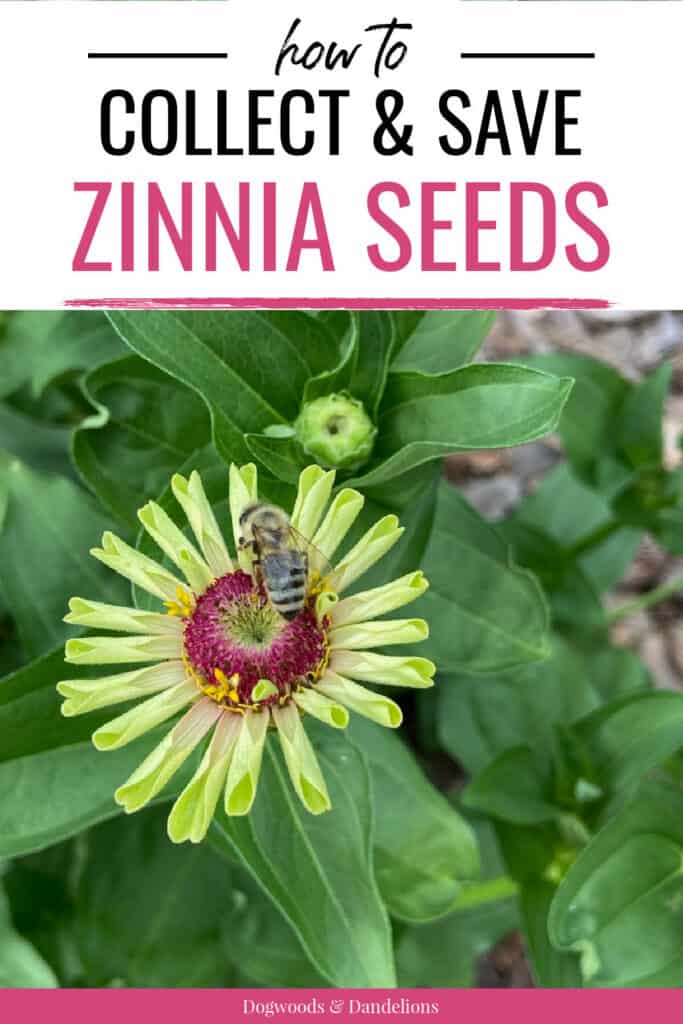How to Collect & Save Zinnia Seeds
Inside: Learning how to save zinnia seeds can save you money on flowers next year. They are one of the best flowers for beginning gardeners to grow.
Growing flowers in the garden is one of life’s greatest pleasures. But since I grow a large vegetable garden, I don’t have lots of time to devote to growing flowers. So I like easy-to-grow varieties. And zinnias are so easy to grow.
Zinnias (Zinnia Elegans) are a beautiful flower to grow in your landscape and flower gardens, but they are also a great flower to grow among your vegetables.
They are great for attracting bees, butterflies, and other pollinators. Zinnias also make great cut flowers to bring indoors. They are annual flowers that will need to be replanted every year.
Zinnias come in a variety of colors so there is sure to be a variety that will suit your garden and landscape.
But there are a few things you need to know before you start to save zinnia seeds for next year.
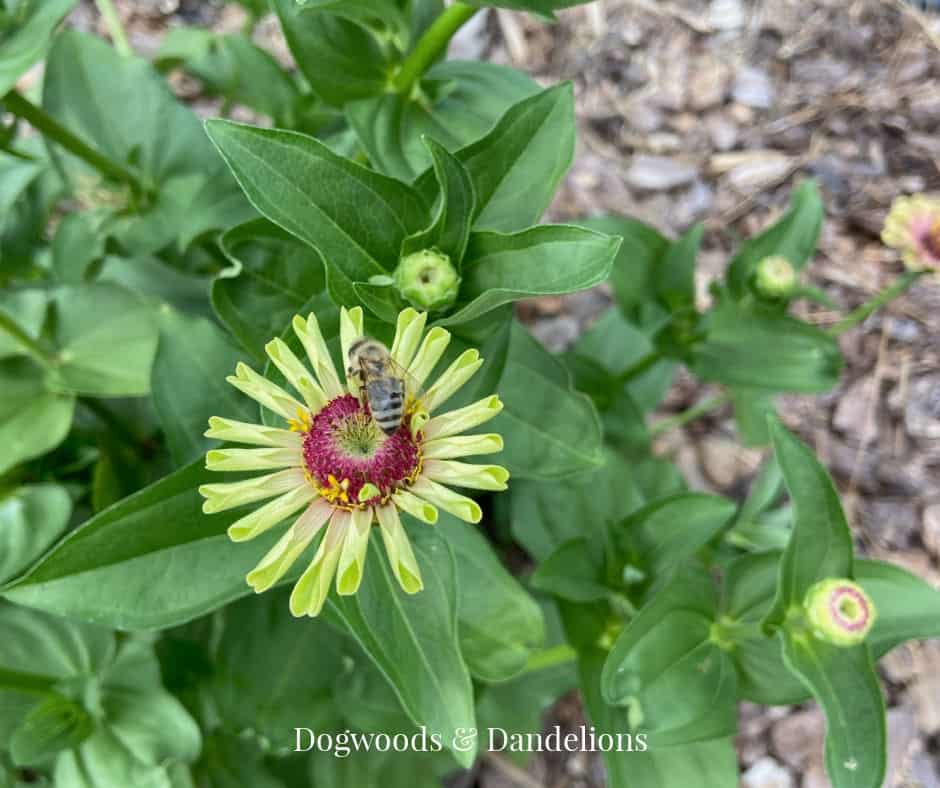
Affiliate Disclosure: Please note that some of the links in this article may be affiliate links and I may receive a small commission if you purchase something through a link. It will not change your cost. As an Amazon Associate, I earn from qualifying purchases. For more information, see my disclosures page.)
Open-Pollinated vs. Hybrid Zinnias
One of the first things you need to do is determine whether your zinnias are open-pollinated or a hybrid variety. Open-pollinated seeds will produce a flower that looks the same as the flower you grew the prior year. (For a list of some popular open-pollinated varieties of zinnias, see the bottom of this post.)
Hybrids, on the other hand, may look like a completely different zinnia than the parent plant. If you no longer have the seed packet or know what variety you planted, there is no harm in saving the seeds of hybrid varieties.
But when you plant hybrid zinnia seeds, you just can’t be sure what the flower of the resulting plant will look like. They might look like the original plants or they could be vastly different. However, you may be pleasantly surprised and get a flower you totally love.
Even if you know you have open-pollinated varieties, you can get accidental crosses if you have more than one variety of zinnias nearby. Bees and other pollinators will flit from flower to flower and transfer pollen at will.
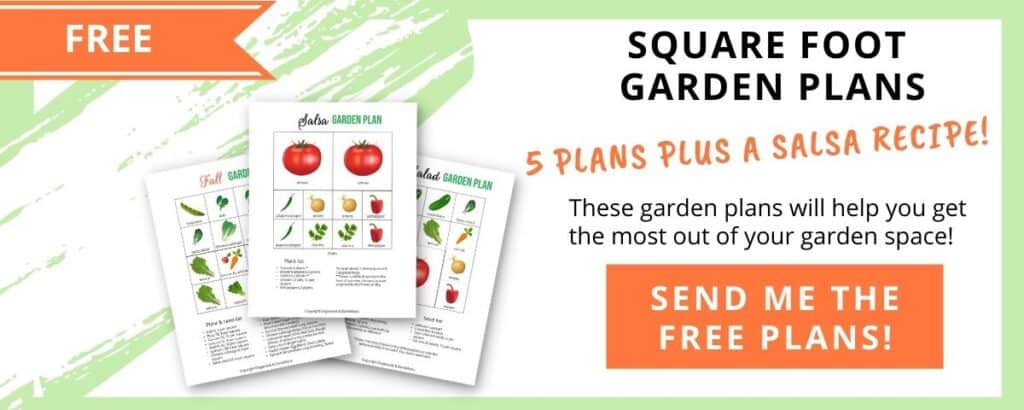
Even neighbors who have different varieties of zinnias can affect the outcome of your open-pollinated zinnias. Bees can travel great distances to collect pollen from various plants.
For more information about the difference between open-pollinated, hybrid, and heirloom varieties, see Open-Pollinated vs. Hybrid Seeds-Which Should You Choose?
If you are serious about saving zinnia seeds that come true to the parent plant, be sure to follow the steps below.
How to Cover Zinnia Seed Buds
If you don’t want accidental crosses, you can cover the zinnia bud with netting to keep it from accidentally being pollinated. Don’t use plastic bags as they will hold moisture in and cause the seeds to mold.
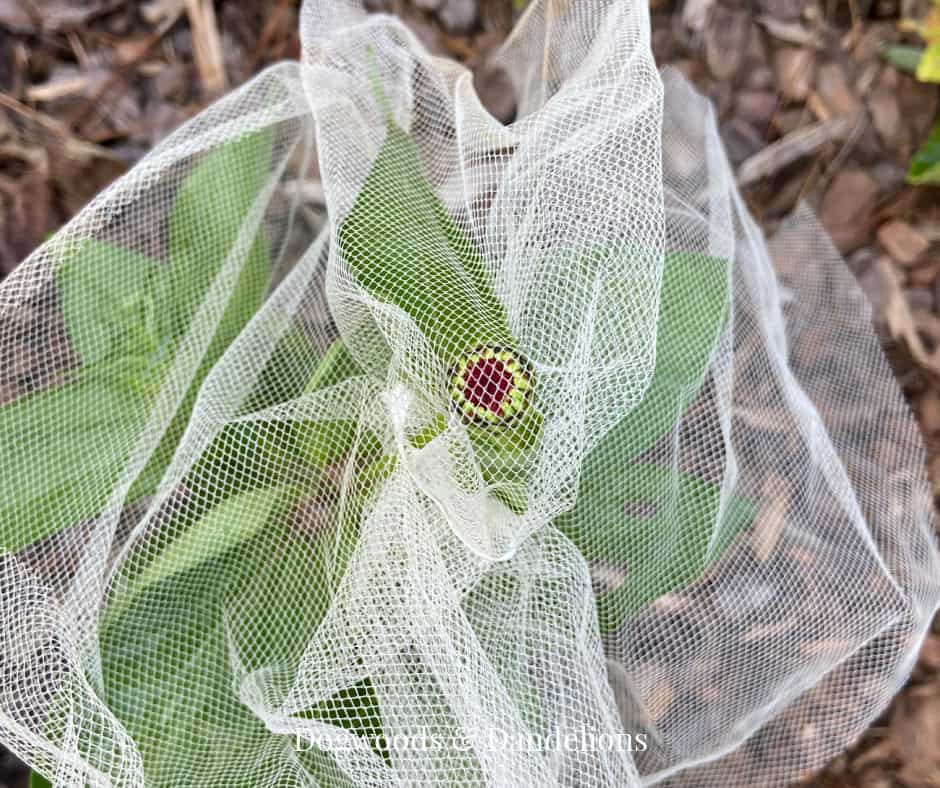
You can even purchase net bags that make the job of covering the buds super easy. Covering the flower bud with netting should be done before the flower ever begins to open.
When choosing which zinnia flowers to save, you need to be sure that the plants don’t have any diseases that could potentially be transmitted to next year’s flowers.
Check your zinnia plants for powdery mildew or Alternaria leaf spot and other diseases before saving the seeds. Only save seeds from disease-free plants.
I also recommend choosing flowers that aren’t as visible to allow to go to seed. You have to let the flower turn brown and dry on the plant, so saving zinnia seeds can look a bit ugly. Choosing flowers to save from the back of the plant will probably be less visible than the ones at the front.
Allow your chosen seed heads to dry on the plant. Cutting them too soon may mean they won’t dry properly. You probably only need to collect 2-4 zinnia heads to harvest plenty of seeds for the following year.
Once you’ve decided which seed heads to leave on the plant, you want to continue to deadhead the other flowers as soon as they die back. Removing spent flowers will keep your zinnias looking beautiful and producing new flower buds.
How to Collect Zinnia Seeds
Choose a dry day to harvest your zinnia seeds. Be sure your seed heads are dry and mostly brown. You want to harvest the dried flower heads in late summer before your first fall frost.
Cut the seed head from the plant, being sure to label the heads as you collect them if you want to keep varieties separate.
Find a cool dry place indoors to store the seed heads for a couple of weeks to ensure they are thoroughly dry. A place with good ventilation is preferred.
After a couple of weeks, spread newspaper or paper towels over your work surface. Label a paper plate with the name of each zinnia variety.
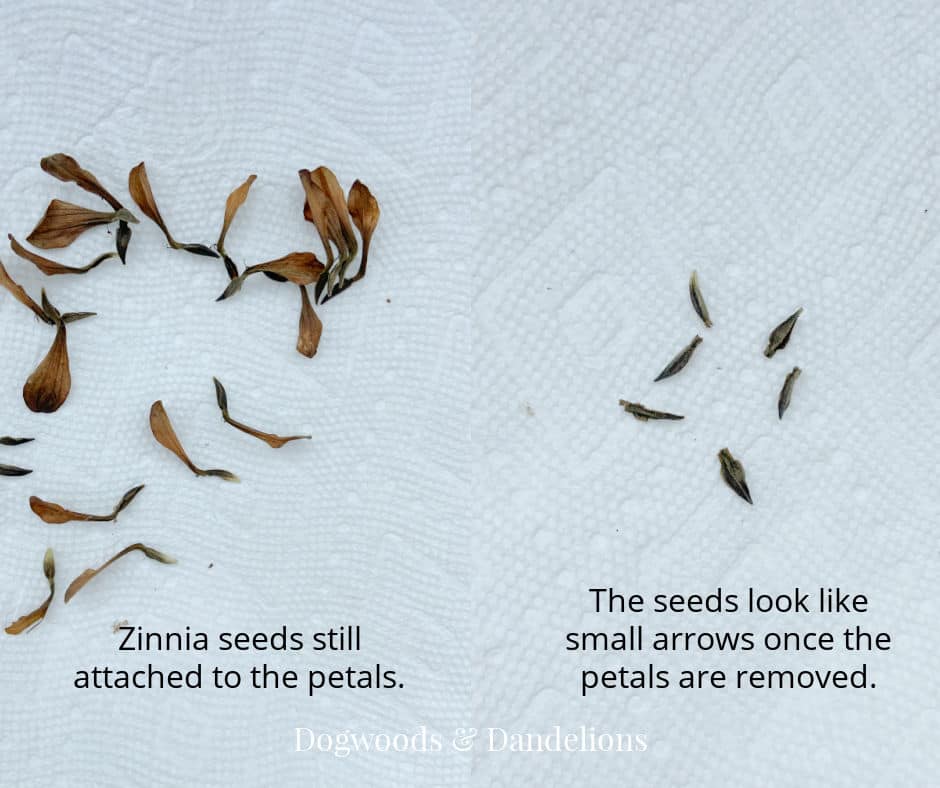
Rub the seed head over the paper plate to release the seeds. The seeds actually look like little arrows and are attached to the end of the petals. You may have to gently pull the seeds from the seed head if they don’t come out easily.
Spread the loose seeds out in a single layer on the plate and place them in a cool, dry location to allow any remaining moisture to evaporate. Be sure the area you choose has little wind or isn’t near a fan. Otherwise, your seeds may blow off the plate.
After the seeds have dried for a few more days, place them in a labeled envelope. You can purchase small paper envelopes or buy seed storage envelopes specifically for this purpose.

How to Store Zinnia Seeds
Once you have the seeds harvested and dry, you need to be sure to store them properly so they will germinate the following year. Moisture is the enemy of seeds. You don’t want to re-introduce moisture to the seeds after you have so carefully preserved them.
Once you have placed all the seeds in envelopes, place the envelopes in a sealed glass jar or plastic container in a cool, dark place. Seeds will keep for 3-5 years if stored properly.
However, after three years, your germination rates will start to decline. The easiest solution is to just plant a few extra seeds each year if you are using older ones.
Open-Pollinated Varieties of Zinnias
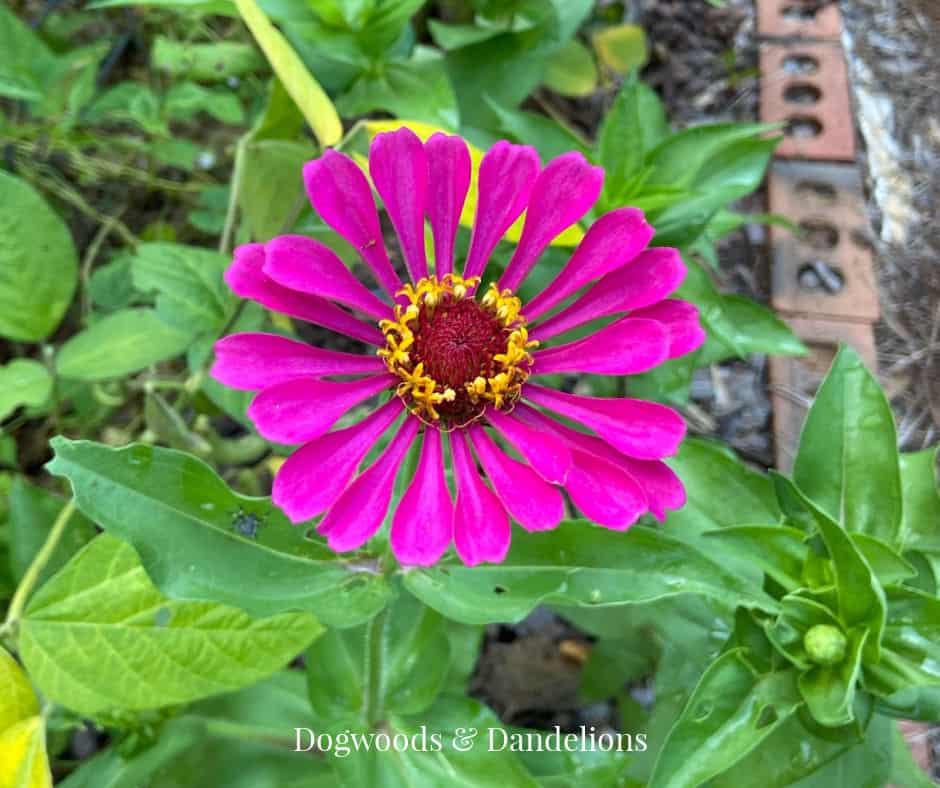
This list contains some of the most popular open-pollinated varieties of zinnias. While this list isn’t all-inclusive, you should be able to locate at least a few of these varieties in local stores. Many online seed stores such as Ferry Morse carry these varieties also.
- Benary’s Giant
- Cactus Mix
- California Giant
- Canary Bird
- Candy Cane Mix
- Gold Medal Mix
- Green Envy
- Inca
- Jazzy Mix
- Lilliput Mix
- Pumila Mix
- Scarlet Flame
- State Fair Mix
Zinnia’s Are So Easy to Grow
Zinnia seeds are one of my favorite flowers to grow, not only in my flower garden but also to attract bees to my vegetable garden. They come in such a diverse range of colors and shapes that you are bound to find a variety you love for your garden.
Zinnias are one of the easiest flowers to grow from seed, so there is no need to purchase plants from your local store. You can easily plant the seeds right in the garden next spring after all danger of frost has passed. You will have lovely flowers from July to frost.
And now that you know how to save zinnia seeds, you can have the same beautiful varieties in your yard every year.
Related Posts
- How to attract pollinators to your vegetable garden
- How to grow irises
- Growing flowers in the vegetable garden
- How to store seeds for later
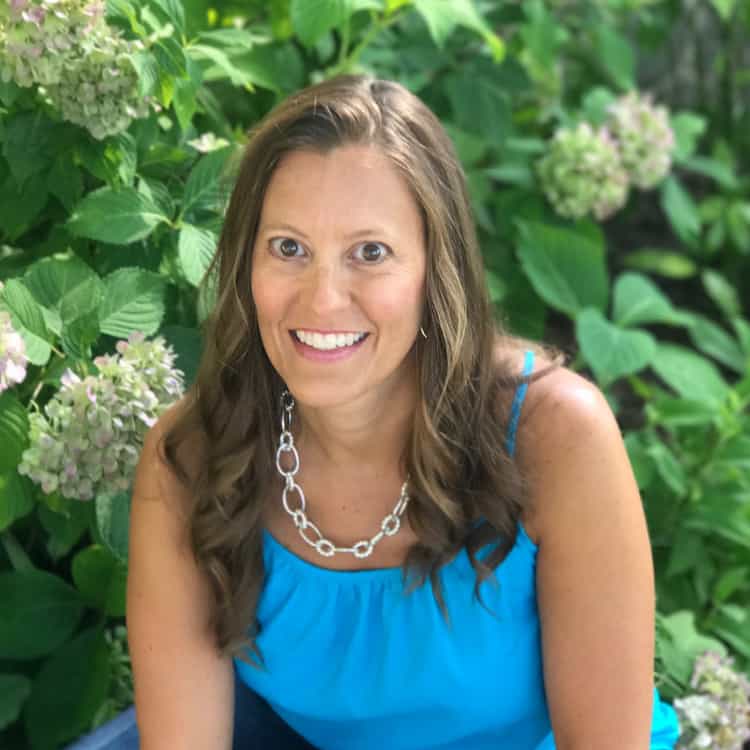
Meet Julie
I’m a farm girl born and bred in North Carolina. I’ve been growing a vegetable garden for over 20 years (and helping my Mom grow hers even longer). I’ve been raising chickens in my bathtub and backyard for 12+ years. I believe that homegrown food can be made simple. Let’s get started.
